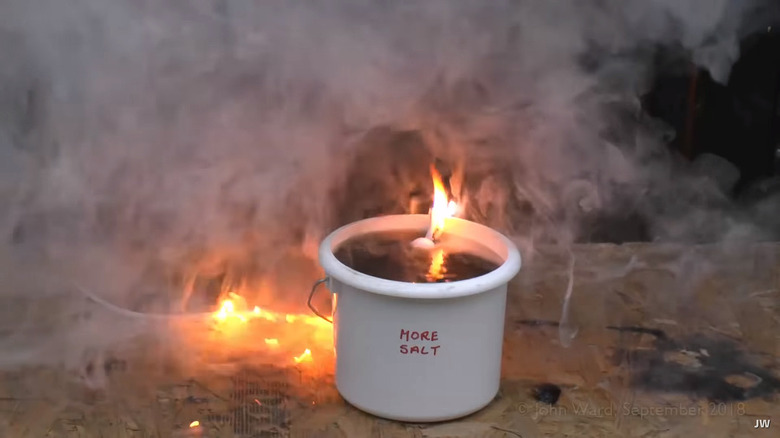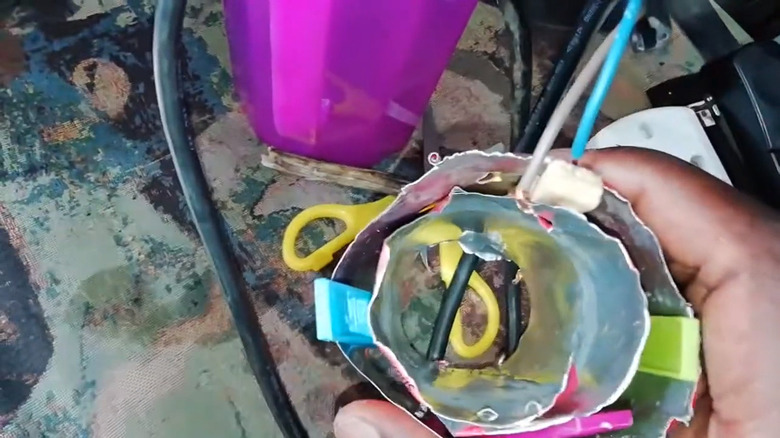Think Twice Before Using Old Soda Cans To Create A Makeshift Water Heater. Here's Why
Some things make you reach, instinctively ... a falling child, a dropped smartphone, a $20 bill fluttering, unaccompanied, down the street. The thing that's made us reflexively reach out most recently is YouTuber @bassoniatv's video on how to "create [an] electric water heater" using an aluminum can. We reached for our phones to dial 911. We reached for a fire extinguisher. If we'd had one, we probably would have reached for a defibrillator as well. What Bassonia TV, purveyor of videos about topics as varied as fixing printers and breaking into a Fiat 500, has created for us all is a guide to making your own DIY electrode boiler, the most dangerous way to heat water short of maybe setting your office chair on fire and putting a tea kettle on it.
Not that electrode boilers are inherently dangerous. Commercial models are used for heating water in industrial environments, and for regulating power grids. But these are safe in the same way a passenger plane is safe: when not constructed and operated based on an 11-minute YouTube video. Let's take a closer look at what's wrong with the soda can water heater concept, and why no amount of improvement will make it safe. You're better off smashing the cans and using them as cheap drainage for your plant pots. A DIY rocket heater is a far safer way to generate hot water in an emergency, and it doesn't even require electricity.
How electrode boilers work, and how they don't
If you've ever changed one of the heating elements on an electric water heater, you're familiar with the heating mechanism ... typically a metal tube that houses an insulated resistor. The resistor converts electricity into heat, in much the same way as the wires in an electric blanket or the filament in an old incandescent light bulb does. This element is submerged in water and heats it under the control of a thermostat and the natural temperature limitation of liquid water, which can't exceed the boiling point. An electrode boiler treats water itself as the resistor: electricity is converted to heat using the resistivity and conductivity of the water itself. Which would be fine, except what you're doing in this case is running a full-strength mains AC current through an open cup of water.
Think about all the places in your home where you can easily — or even accidentally — reach out and touch a conductor carrying 120-volt of mains power. You probably can't come up with one, and there's a reason for that. Code-compliant electrical wiring is designed and regulated around a few simple principles, and one of them is preventing people from being electrocuted by touching electrical conductors. Another is avoiding the uncontrolled conversion of electricity into heat, which at some point begins to go by the name "fire." YouTuber John Ward tested a teacup electrode boiler with more conductive salty water, which resulted in the device's wiring quickly catching fire.
What else could go wrong?
The device that caught fire for John Ward is functionally identical to @bassoniatv's electrode boiler, though better constructed. The @bassoniatv version works by nesting an aluminum can inside a slightly larger can. One is wired to the line conductor of an outlet and the other to the neutral conductor. The tops and bottoms of these cans have been cut away, resulting in a hopelessly floppy contraption with one major safety requirement: the cans must not touch each other. This is something like playing the child's electric game Operation with a noodle instead of a hard plastic spleen or whatever: you must not allow the cans to touch, but this design seems purpose-built to make following that directive as difficult as possible. One look at the contraption shows how dicey the construction can be.
The narrator recommends using "wood" between the cans as an insulator, possibly in the mistaken belief that wood is a poor conductor. In fact, damp wood can be quite an effective conductor. Assuming you manage to thread the needle of assembling this device and submerging it in water without ever allowing the super-flexy cans to flex and touch each other, you must rely on fate to prevent a cat, curious child, or mis-kicked football from bumping the resulting "water heater." Such an accident would result in either an electrical shock from the water or shorting the aluminum cans against each other, which could trip a circuit breaker, start a fire, or both.


